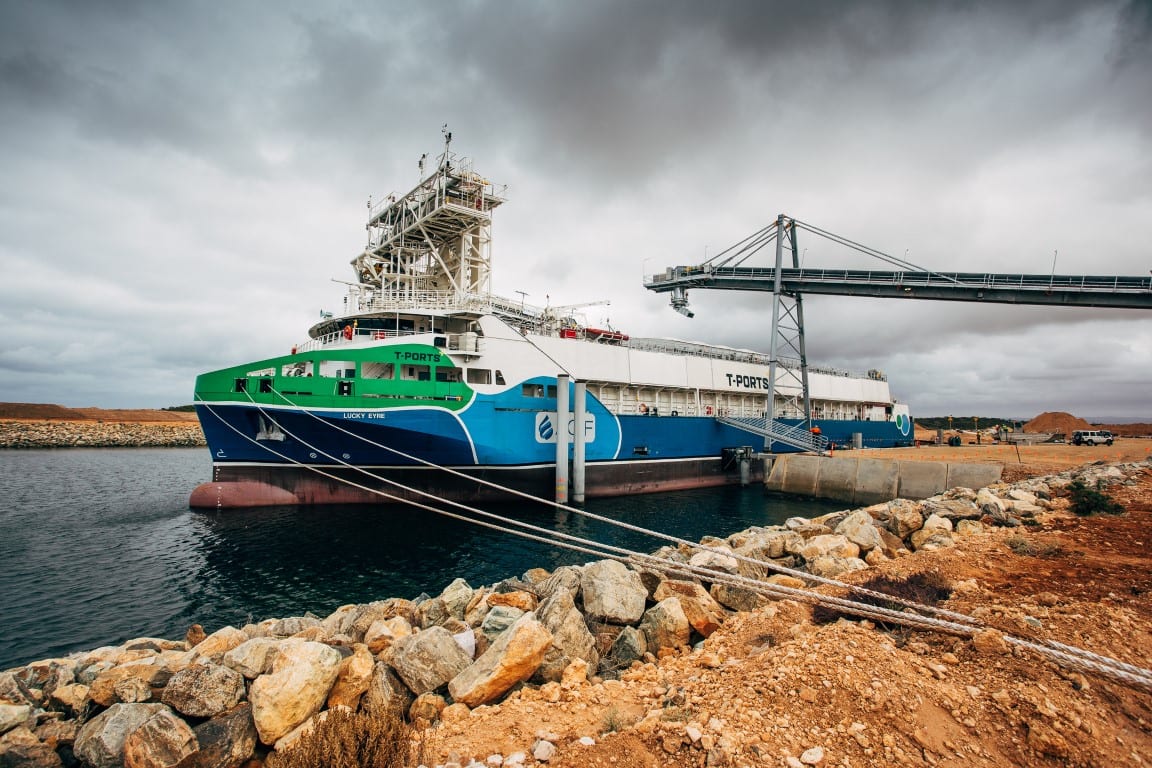About T-PORTS
T-Ports specialises in innovative solutions for the export of Australian commodities, partnering with customers and investors to use a flexible model that positions port infrastructure close to the product’s origin.
What We Do

Tranship

Commodities

Global
About T-PORTS
As a port and transhipment vessel design, build, own and operating company, T-Ports offers a comprehensive long-term supply chain solution, including financing, design, construction, delivery, management and operation of port and transhipment operations.
The T-Ports innovative business model offers financing options for supply chain solutions, providing equity against throughput to key customers.
By moving the port closer to the product, there is a reduction in domestic haulage distances, a reduction in regional road budgets and a reduction in carbon dioxide emissions. Resources that are uneconomical due to long haulage distances become economical when the port is moved significantly closer to the product.
We are passionate about driving inevitable changes to port construction and marine operations using disruptive advanced technology to decentralise assets and increase efficiency.
We require a fraction of the capital expenditure to build shallow-water ports compared to a deep-water facility and operating expenses are highly competitive in comparison.
By offering skills and knowledge in planning, designing, engineering and building infrastructure, T-Ports offers a unique solution to customers, allowing the development of efficient port infrastructure to ensure project’s economic viability.
Have a project or development?
Talk to us about how we can help.
Our origins
T-Ports specialises in innovative solutions for the export of commodities, partnering with customers and investors to use a flexible model that positions port infrastructure close to the product’s origin.
T-Ports was established in 2018 to initiate the Lucky Bay Port Facility development, securing private investor equity and debt.
The name T-Ports is based on the use of transhipment vessels, reflecting the innovation central to the Lucky Bay project in moving away from the region’s traditional port model.

The T-Ports difference
T-Ports’ infrastructure strategy centres on developing a more financially feasible ports model. This includes shallow water ports with a lower build cost and smaller environmental footprint requiring modest throughput, providing sound financial returns to investors.
T-Ports – bringing the port to the product
multi-user, multi-commodity ports
Growers
The benefits of transhipment

Reduced port charges
Transhipment involves using smaller feeder vessels.

Faster transfers
T-Ports achieves faster transfer rates than conventional transhippers.

Financial safety
Financial risk is reduced as companies have a smaller footprint in on-shore infrastructure.

Lower requirements
Lower manning and power requirements than conventional export systems.
About transhipment
For Lucky Bay and Wallaroo, T-Ports uses a shallow draft feeder vessel designed for shallow harbours. This is a quad screw, stern landing vessel suitable for bulk commodities or containers.
This transhipment vessel operates when wind speeds are 20 knots or below and wave heights up to 2.5 metres.
At our Ports at Lucky Bay and Wallaroo, the transhipment vessel will load five nautical miles from the port.

Transhipment vessel
The ‘Lucky Eyre’
The transhipment vessel (TSV), MV Lucky Eyre, will load grain from port and unload onto deep water vessels five nautical miles from the port. It is capable of loading up to Panamax size vessels.
The Lucky Eyre is an 87-metre self-propelled, self-discharging vessel with a capacity of between 3,300 and 3,500 tonnes and a nameplate loading capacity of up to 13,800 tonnes per day.
Previously unseen in Australia for grain exports, the use of a transhipment vessel means T-Ports requires less than four metres of depth in the harbour, eliminating the need for major jetty structures and other port infrastructure.
T-Ports transhipment technology is capable of operating in seas of up to 5m wave height and 30 knot winds.
A transhipment port facility has a much lower environmental footprint, reducing the ecological disturbance in comparison to deep water facilities.
Due to the port being located close to the product, these facilities substantially reduce the road haulage distances, hence reducing the cost to government for road repairs and maintenance and reducing carbon dioxide emissions considerably.
Resources that are uneconomical due to long haulage distances, and the cost of same, become economical when the port is moved significantly closer to the product.
-
Fully designed and constructed under T-Ports order, commissioned March 2020.
-
87m in length, 18m breadth.
-
Self-discharging at 1,200tph (2 x 600tph bucket elevators).
-
Self-propelled, quad screw with 4 x 625Hp drive motors, bow thrusters.
-
Zero ballast, full ocean-going capabilities.
-
3,200 tonnes of wheat capacity
-
Stern ramp / RORO capability
-
8 Crew, T-Ports employees.
-
1.8m draft empty, 3.9m draft fully laden.
-
Travelling gantry scraper feed into elevator hoppers.
